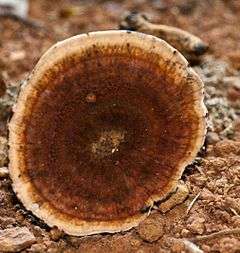Amauroderma rude
Amauroderma rude is a tough woody mushroom in the family Ganodermataceae.[2] A polypore fungus, it is found in Eastern Australia, where it grows as a saprophyte on rotting, buried wood.[3]
| Amauroderma rude | |
|---|---|
 | |
| Scientific classification | |
| Kingdom: | |
| Division: | |
| Class: | |
| Order: | |
| Family: | |
| Genus: | |
| Species: | A. rude |
| Binomial name | |
| Amauroderma rude | |
| Synonyms[1] | |
| |
| Amauroderma rude | |
|---|---|
float | |
| pores on hymenium | |
| cap is flat or depressed | |
| stipe is bare | |
| spore print is brown | |
| ecology is saprotrophic | |
| edibility: unknown or inedible | |
Etymology
Amauroderma means "dark/dusky-skinned" (from amauro, meaning "dark or dusky", and derma, meaning "skin").[2] The second half of the binomen, rude, means "robust".[2]
Description
Fruit bodies have caps that are typically 4–8 cm (1.6–3.1 in) wide with alternating bands of light and dark brown rings. On the cap underside are small white to pale grey pores that initially turn red when bruised before turning black; this red-staining behaviour is unique in its genus.[2][3] The light to dark brown stipe measures 5–13 cm (2.0–5.1 in) long by 1–2 cm (0.4–0.8 in) thick.[4]
gollark: … oddly specific codes?
gollark: There are few things rarer than saltkins.
gollark: ... although given breeding cooldowns probably a few.
gollark: I've got 13 mageia total, huh, guess I could finish that IOU in a week or so.
gollark: Well, I do have lots of reds now.
References
- "GSD Species Synonymy: Amauroderma rude (Berk.) Torrend". Species Fungorum. CAB International. Retrieved 2014-04-30.
- Sapphire McMullan-Fisher; Patrick Leonard; Frances Guard (24 April 2014). "Polypores". Australian Subtropical Fungi. Suncoast Fungi. p. 92. ISBN 9780646915524.
- "Amauroderma rude". Fungi Down Under Online. Fungimap. Archived from the original on 15 March 2014. Retrieved 27 April 2014.
- Young, A.M. (2005). A Field Guide to the Fungi of Australia. Sydney, Australia: UNSW Press. pp. 69–70. ISBN 0-86840-742-9.
This article is issued from Wikipedia. The text is licensed under Creative Commons - Attribution - Sharealike. Additional terms may apply for the media files.